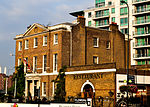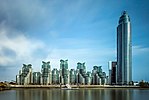One Nine Elms
One Nine Elms is a mixed-use skyscraper scheme currently under construction in Nine Elms, London. It was originally developed by Wanda One, a UK subsidiary company of Dalian Wanda, until they sold the project to R&F Properties, another Chinese firm in 2018. It has been designed by architects Kohn Pedersen Fox (KPF). The development will replace two towers on the site built in the 1970s called Market Towers and forms part of a wider redevelopment of the Nine Elms area of London. The development will include 494 residential apartments and a Park Hyatt luxury hotel. Upon completion, anticipated to be in 2022, One Nine Elms will become one of the tallest residential developments in London and the United Kingdom.
Excerpt from the Wikipedia article One Nine Elms (License: CC BY-SA 3.0, Authors).One Nine Elms
Nine Elms Lane, London Vauxhall (London Borough of Lambeth)
Geographical coordinates (GPS) Address Nearby Places Show on map
Geographical coordinates (GPS)
| Latitude | Longitude |
|---|---|
| N 51.484827 ° | E -0.128072 ° |
Address
Saint George Wharf Tower (Vauxhall Tower)
Nine Elms Lane
SW8 2DA London, Vauxhall (London Borough of Lambeth)
England, United Kingdom
Open on Google Maps










